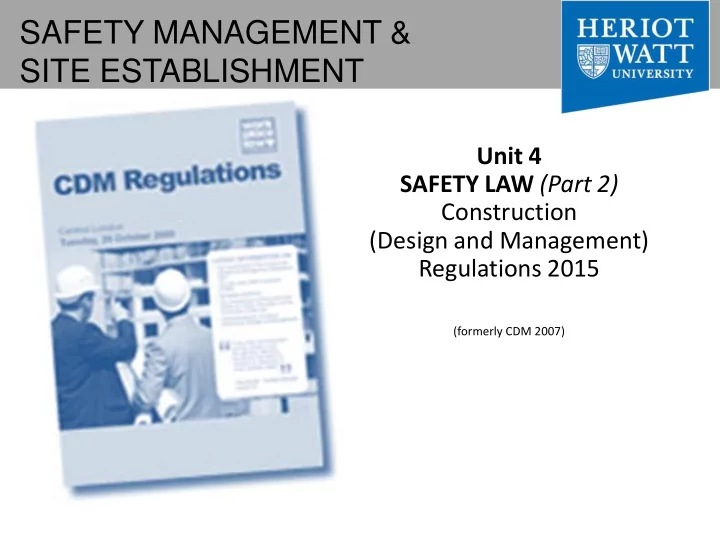

SAFETY MANAGEMENT & SITE ESTABLISHMENT Unit 4 SAFETY LAW (Part 2) Construction (Design and Management) Regulations 2015 (formerly CDM 2007)
Aim of this lecture • Examine CDM Regulations 2015 • Examine the ACoP of CDM Regulations 2015(*) (*) ACoP will be released later in 2015 Learning outcomes Understand the specific requirements imposed by the CDM Regulations 2015 Realise the ‘Duty holders’ under the CDM 2015 regulations Role of duty holders
Background to CDM 2007 (and 2015) Regulations What is the rational of having a health and safety regulation specific to the construction industry? Construction remains a disproportionately dangerous industry where improvements in health and safety are urgently needed The improvements require significant and permanent changes in duty holder attitudes and behavior Since the original CDM Regulations were introduced in 1994, concerns were raised that their complexity and the bureaucratic approach of many duty holders frustrated the Regulations’ underlying health and safety objectives
Background to CDM 2007 Regulations These views were supported by an industry-wide consultation in 2002 which resulted in the decision to revise the Regulations The new CDM 2007 Regulations revise and bring together the CDM Regulations 1994 and the Construction (Health Safety and Welfare) Regulations 1996 into a single regulatory package
History of CDM regulations Construction (Health, Construction (Design Safety and Welfare) and Management) Regulations 1996 Regulations 1994 (CHSW) Construction (Design and Management) Regulations 2007
Number and rate of fatal injury to workers 2004/05 - 2011/12 Source HSE web site
Number and rate of reported major injury to employees 2004/05 - 2011/12 Source HSE web site
Why CDM Regulations ???? • A European study of the Construction Industry fatal accidents concluded that 60% of accidents were due to decisions made before the work began • The EU Directive 92/57/EEC on the implementation of minimum safety and health requirements at temporary or mobile construction sites (the “Construction Sites Directive”) was passed • The CDM Regulations were the UK’s interpretation of the Directive
New Regulations: CDM 2015 • Places legal duties on virtually everyone involved in construction work ('dutyholders’) • Less complicated • Everything in one place • Less paperwork • Much easier for small jobs and domestic clients • Better safety ?
Construction (Design and Management) Regulations 2015 Came into force on 6 April 2015
New Regulations: CDM 2015 The full text of the Regulations, and of the ACOP are available through the following link. http://www.hse.gov.uk/construction/
Working as a group, produce a 15 minutes PPT presentation in one of the following 6 areas; • Group Difference between Acts, Regulations and Codes of Practice (CoPs), • 1: Personal Protective Equipment at Work Regulations • CDM 2015, Part 2: Client duties, • Schedule 1: Particulars to be notified under regulation 6 • Group What construction activities need to be controlled by the law? • 2: What are the relevant legislation? • CDM 2015, Part 3: Health and safety duties and roles, • Group Outline of the Corporate Manslaughter and Corporate Homicide Act 2007 • 3: CDM 2015, Part 4: General requirements for all construction sites, • Enforcement of the health & safety at work act and Inspectors’ powers • Group Outline of the Employers’ Liability (Compulsory Insurance) Act 1999 • 4: Outline of the Health and Safety at Work etc. Act 1974 • CDM 2015, Schedule 2: Minimum welfare facilities required for construction sites, • Group COSHH (The Control of Substances Hazardous to Heath Regulations) • 5: CDM 2015, Schedule 3: Work involving particular risks, • Outline differences between CDM 2007 and 2015 • Group Employer’s duties according to HASWA 1974 • 6: Others with duties according to HASWA 1974 • CDM 2015, Schedule 4: Transitional and saving provisions
Presentation rules; • Every student in the group will present, but appointing a narrator might be useful to assure the “flow”, • Avoid “facts and figures” type of presentation, and produce some material which is interesting, informative, useful to both learn from and teach to peers, • Pay attention to what other groups are presenting because it is a learning and teaching exercise, • Do ask questions: no questions may mean no interest… • Provide supportive peer feedback.
Don’t forget to bring your laptops for the next tutorial session
Recommend
More recommend